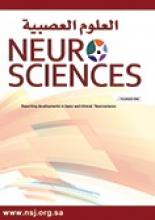The Neurosciences Journal includes this section of multiple choice questions as part of its commitment to continuous education and learning in Neurosciences. Experts in various neuroscience specialties are invited to participate with their knowledge and expertise in this section.
Neurology, neurosurgery, and other board residents are encouraged to read this section to improve their knowledge and direct their reading for written examinations.
Choose the most appropriate single answer.
Fatty filum terminale is due to which disorder of embryogenesis?
Incomplete dysjunction
Premature dysjunction
Disorder of gastrulation
Failure of caudal nuroaxial development
Secondary neurlation
What is the appropriate preiconceptional folic acid supplementation dose in women with a previous history of neural tube defect affected pregnancy?
0.3 mg/day
4 mg/day
0.4 mg/day
3 mg/day
None of the above
The most common urodynamic study abnormalities among patients with tethered cord syndrome are?
Reflexic bladder
Neurogenic overactive detrusor
Detrusor sphincter dyssynergia
All of the above
None of the above
What is the mechanism responsible for neurogenic dysfunction in tethered cord?
Spinal cord ischemia
Spinal cord luxury hyperprefusion
Glucose metabolism
A&C
All of the above
Why should neurosurgeon be aware of meningocele manqué entity?
Because it is not surgical
Meningocele manqué associated with split cord anomaly
When removing the lamina during an operation on a patient with occult spinal dysraphism surgeon can apply pressure on the cord, or cauda equina
Because it might be the cause of tethering for patient above 40 years old
All of the above
Answers:
e
Incomplete dysjunction leads to dermal sinus tract, while premature disjunction causes lipomyelomeningocele, disorders of gastrulation leads to split cord malformation. Failure of caudal nuroaxial neuraxial development leads to caudal regression disorders.1
b
Dose is 4 mg/day which is 10 times higher than the usual prophylactic dose if there is no history of neural tube defects. This dose causes reduction of 72% in the neural tube defect recurrence rate.2
d
The results of urodynamic study vary between tethered cases depending on the level of the lesion and the severity of tethering.3
d
Cord tethering associated with stretching produces excessive tension within the spinal cord and can result in metabolic derangement, and a decrease in blood flow and glucose metabolic impairment with cytochrome reduction. Increases in the blood flow are reported to be associated with post surgical improvement.4
c
Tethering bands from the spinal cord to dura or under surface of laminae are rare anomaly. These bands known as meningocel manqué (manqué: French for missing) and usually presented with other spinal anomalies. If the surgeon is not aware of this condition, he can inadvertently apply tension on under lying neural tissue. Howeveres, it is the only reversible pathological process in tehterd cord cases. Although (b) is correct, (c) is the most single correct response.5,6
- Copyright: © Neurosciences
Neurosciences is an Open Access journal and articles published are distributed under the terms of the Creative Commons Attribution-NonCommercial License (CC BY-NC). Readers may copy, distribute, and display the work for non-commercial purposes with the proper citation of the original work.






